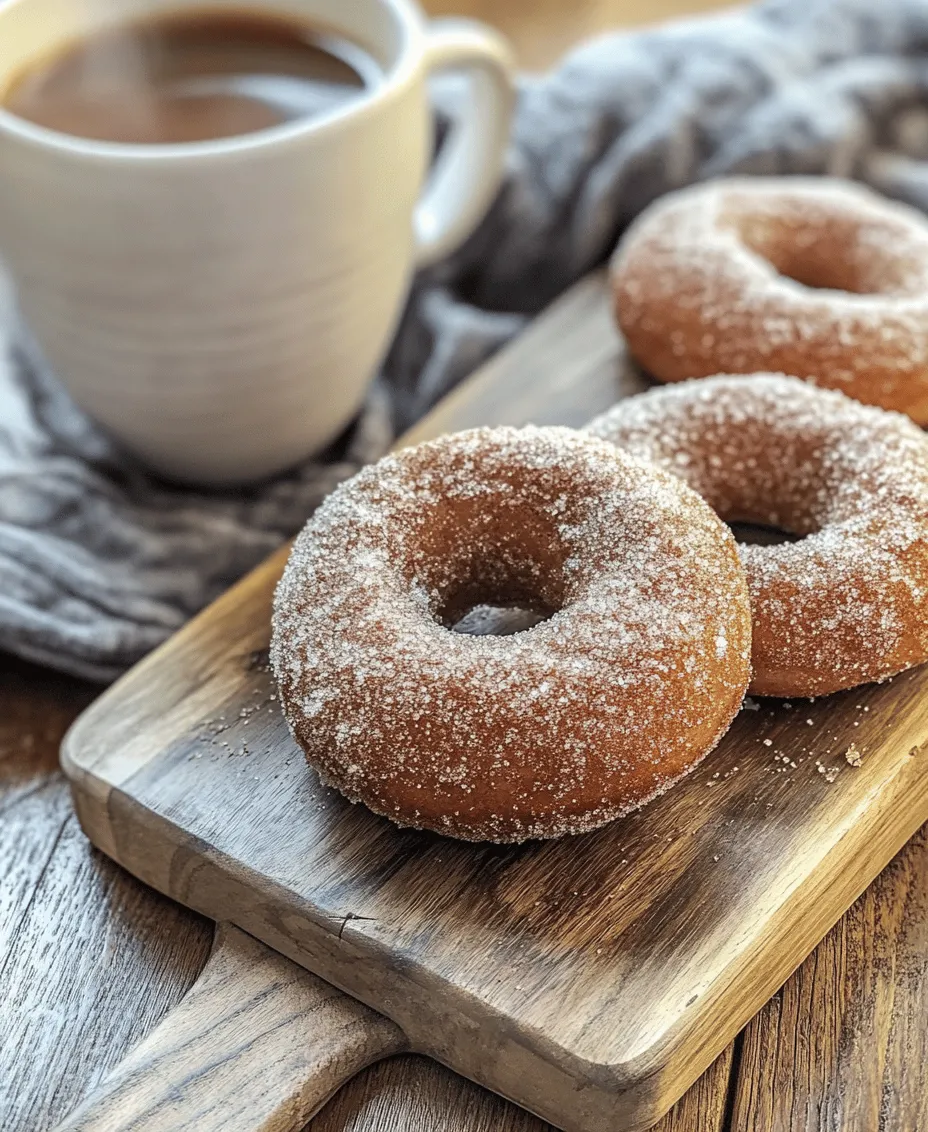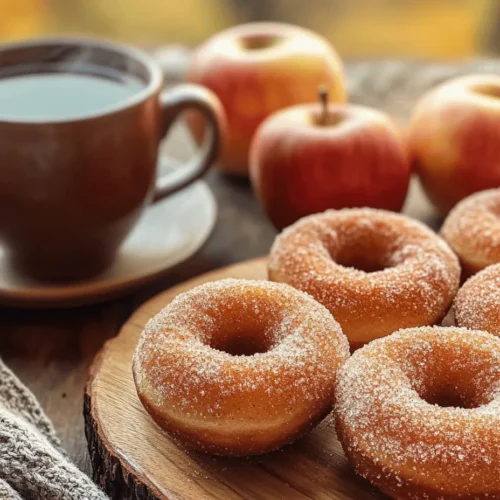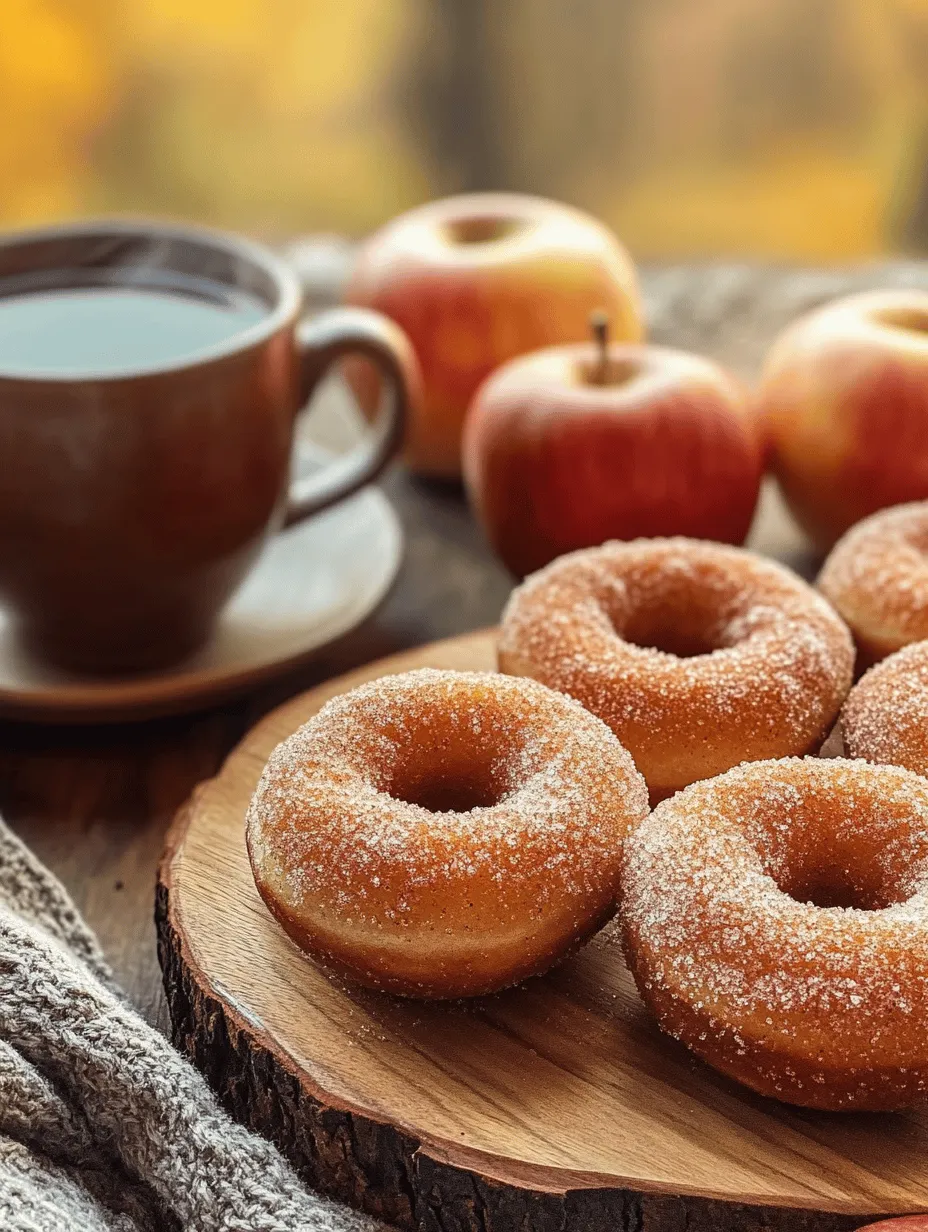Introduction
As the leaves begin to change and the air turns crisp, there’s something undeniably special about the arrival of apple cider donuts. These delightful treats embody the essence of fall, capturing the flavors and aromas of the harvest season in every bite. From bustling farmers’ markets to cozy cider mills, apple cider donuts have become a beloved staple, evoking warm memories of autumn festivities. Whether enjoyed at a local fair or freshly baked at home, they are sure to bring a smile to anyone’s face.
Homemade treats like apple cider donuts have a unique way of creating memorable experiences, filling the kitchen with enchanting aromas that beckon loved ones to gather around. The process of baking not only brings joy but also offers an opportunity to explore the rich flavors of the season. In this article, we will delve into an irresistible apple cider donuts recipe, highlighting the unique flavors and textures that make them a must-try.
The Allure of Apple Cider Donuts
Apple cider donuts have a rich historical context, deeply rooted in autumn traditions. Originating in New England, these treats have been a favorite for generations, often found at local fairs and cider houses. Their popularity can be attributed to the combination of fresh apple cider and warm spices, which together create a comforting treat that embodies the spirit of the season. The experience of biting into a freshly fried or baked donut, with a hint of apple and a dusting of cinnamon sugar, is one that many have cherished since childhood.
The aroma of apple cider donuts wafting through the air is a nostalgic reminder of family outings to orchards, where the joy of picking apples is often followed by indulging in these sweet delights. The warm, comforting flavors of cinnamon and nutmeg, combined with the sweetness of apples, create a sensory experience that is hard to resist. They not only satisfy a sweet tooth but also evoke memories of fall gatherings, hayrides, and cozy evenings spent with loved ones.
Understanding Key Ingredients
To create the perfect apple cider donuts, it’s essential to understand the key ingredients that make them so irresistible. Each component plays a significant role in the flavor, texture, and overall enjoyment of the donut.
Apple Cider
At the heart of this recipe is apple cider, a quintessential ingredient that defines these donuts’ flavor profile. Using fresh, local cider offers the best results, as it provides a robust apple taste that store-bought options often lack. Fresh cider is typically unfiltered and unpasteurized, preserving the natural sweetness and complexity of the apples. This richness enhances the donuts, making each bite a burst of fall flavor.
In addition to flavor, apple cider brings moisture to the batter, ensuring that the donuts remain soft and tender. The process of reducing the cider also intensifies its flavor, concentrating the sweetness and deepening the apple notes that make these donuts so appealing.
Flours: All-Purpose vs. Whole Wheat
When it comes to choosing the right flour for your apple cider donuts, the decision between all-purpose and whole wheat can significantly affect the final product. All-purpose flour is commonly used in donut recipes for its light and airy texture, which results in a fluffy donut. It allows the donuts to rise beautifully and maintain a tender crumb.
On the other hand, incorporating whole wheat flour adds a nutty flavor and contributes a heartier texture to the donuts. Whole wheat flour is also a more nutritious option, as it contains more fiber, vitamins, and minerals compared to its refined counterpart. Mixing both flours can provide a balance, offering the lightness of all-purpose flour while benefiting from the nutritional value of whole wheat.
Spices: Cinnamon and Nutmeg
No apple cider donut is complete without the warm spices that enhance its flavor. Cinnamon and nutmeg are classic choices that complement the sweetness of the apples and the richness of the cider. Cinnamon not only adds warmth and sweetness but also boasts health benefits such as anti-inflammatory properties and improved blood sugar levels.
Nutmeg, with its slightly sweet and nutty flavor, adds depth to the overall taste profile of the donuts. It pairs beautifully with cinnamon, creating a comforting and aromatic blend that is synonymous with fall baking. Both spices contribute to the nostalgic experience of enjoying apple cider donuts, making them a beloved choice for seasonal celebrations.
Eggs and Oil
Eggs play a crucial role in baking, acting as a binding agent that helps to hold the ingredients together. They also contribute to the structure of the donuts, providing stability and a rich flavor. The proteins in eggs help to create a tender crumb, ensuring that the donuts are not only delicious but also have the right texture.
Oil is another important ingredient that adds moisture to the batter. It helps keep the donuts soft and prevents them from becoming dry. Choosing the right type of oil, such as vegetable or canola oil, ensures that the flavors of the spices and cider shine through without overpowering the overall taste.
Step-by-Step Guide to Making Apple Cider Donuts
Now that we have explored the key ingredients, let’s dive into the step-by-step guide for making these irresistible apple cider donuts. The process begins with reducing the cider, a crucial step that concentrates its flavor and elevates the overall taste of the donuts.
Reducing the Cider
The first step in creating your apple cider donuts is to reduce the cider. This process involves simmering the cider on the stove until it thickens and the flavors intensify. Start by pouring your fresh apple cider into a saucepan and bringing it to a gentle boil. Reduce the heat to low and allow it to simmer uncovered, stirring occasionally to prevent it from scorching.
The goal is to reduce the cider to about one cup, which can take approximately 15-20 minutes. You want the consistency to be syrupy but not overly thick; it should still pour easily. The reduction process is essential for intensifying the apple flavor, ensuring that every bite is packed with the essence of fall.
Preparing the Donut Pan
While the cider is reducing, it’s important to prepare your donut pan. Greasing the pan thoroughly is essential to prevent the donuts from sticking and to ensure they come out easily once baked. You can use a non-stick cooking spray or brush the pan with melted butter, making sure to coat each cavity evenly.
Preheating the oven is another crucial step. Aim for a temperature of 350°F (175°C). A properly preheated oven creates the ideal environment for the donuts to rise and bake evenly. As you prepare the pan and preheat the oven, the anticipation of the delicious aroma that will soon fill your home begins to build.
In the next section, we will continue with the detailed instructions for mixing the batter, baking the donuts, and coating them in cinnamon sugar for the final touch. Stay tuned to learn how to create these delightful apple cider donuts from scratch!

Overview of Donut Pans and Their Variations
When it comes to baking apple cider donuts, the right pan can make a significant difference in both the appearance and texture of your treats. Donut pans are typically made of metal or silicone and come in various shapes and sizes. The most common types are standard donut pans with six cavities, mini donut pans that create bite-sized portions, and even specialty pans that allow for unique shapes. Metal pans tend to produce a crispier edge, while silicone pans can yield softer, more tender donuts.
Choosing the right pan for your recipe can enhance your baking experience and the final product. For this apple cider donut recipe, a standard metal donut pan is ideal for achieving that classic form and texture. Always remember to grease your pan adequately to prevent sticking, especially if you are using a metal pan.
Mixing Dry Ingredients
To begin the dough for your irresistible apple cider donuts, you’ll need to gather your dry ingredients. These typically include all-purpose flour, sugar, baking powder, baking soda, salt, and an array of spices like cinnamon and nutmeg.
Start by measuring out the flour and other dry ingredients accurately. Using a kitchen scale can ensure precision, which is crucial for the best results. In a large mixing bowl, combine the flour, sugar, baking powder, baking soda, salt, and spices. Whisk them together thoroughly to ensure even distribution. This step is essential, as it helps to prevent clumping and guarantees that every bite of your donuts is flavorful.
Techniques for Ensuring Even Distribution of Ingredients
Evenly mixing dry ingredients is critical for achieving consistent flavor and texture in your donuts. Use a whisk to aerate the flour and break up any lumps. Once combined, you can sift the mixture through a fine-mesh sieve if you want to ensure it’s extra smooth and free from clumps. Take your time during this step; a well-mixed dry ingredient base is foundational to successful baking.
Combining Wet Ingredients
Now, let’s move on to the wet ingredients. For this recipe, you’ll need eggs, apple cider, melted butter, and vanilla extract. It’s crucial to bring your ingredients to room temperature before mixing. Cold eggs or butter can lead to uneven batter consistency.
In a separate bowl, crack the eggs and beat them lightly until the yolks and whites are well combined. Then, gradually mix in the apple cider and melted butter, followed by the vanilla extract. Make sure that the melted butter has cooled slightly before adding it to avoid cooking the eggs.
Tips for Properly Beating Eggs and Mixing with Cider
When beating the eggs, aim for a light and frothy consistency, which incorporates air and contributes to a fluffier donut. This process should take about 1-2 minutes. Once your wet ingredients are well blended, pour them into the bowl with the dry ingredients.
Creating the Batter
As you combine the wet and dry mixtures, it’s important to focus on the technique of folding rather than traditional mixing. Folding involves gently combining the ingredients, allowing you to maintain the airiness of the batter. Overmixing can lead to dense, chewy donuts, which is not the desired outcome.
Signs of Perfect Batter Consistency
The perfect batter for your apple cider donuts should be thick yet pourable, similar to a cake batter. It should drop from a spoon but hold some shape. If it’s too runny, consider adding a bit more flour; if it’s too thick, a splash of cider can help achieve the right consistency.
Filling the Donut Pan
Once your batter is ready, it’s time to fill the donut pan. To do this efficiently, consider using a piping bag or a zip-top bag with a corner cut off. This method allows for precise filling and minimizes mess.
Tools That Can Assist in Filling the Pan
There are several tools available that can assist in filling your donut pan. A cookie scoop can help portion out the batter evenly, while a piping bag ensures that each cavity receives an equal amount of batter.
Tips for Achieving Uniform Donut Shapes
To achieve uniform donut shapes, fill each cavity about halfway. This allows the donuts to rise without overflowing. If you’re using a mini donut pan, adjust your filling accordingly, typically filling each cavity one-third full.
Baking the Donuts
Preheat your oven to 350°F (175°C) while you prepare the batter. Once filled, place the donut pan in the oven and bake for about 10-12 minutes.
Key Indicators for Doneness
You’ll know your donuts are ready when they are golden brown and spring back lightly when touched. A toothpick inserted into the center should come out clean, indicating they are fully baked.
Common Mistakes to Avoid During Baking
One common mistake is opening the oven door too early, which can cause the donuts to deflate. Ensure that you wait until the minimum baking time has passed before checking on them. Additionally, avoid overcrowding the oven, as this can lead to uneven baking.
Cooling and Coating Process
Once your apple cider donuts are baked to perfection, it’s vital to allow them to cool in the pan for about 5 minutes before transferring them to a wire rack. This cooling period helps the donuts set and makes them easier to handle.
Importance of Cooling Before Coating
Allowing the donuts to cool slightly before coating them in sugar or glaze is crucial. If they’re too hot, the sugar will melt and create a messy coating rather than a delightful sugary crust.
Techniques for Achieving an Even Sugar Coating
To coat your donuts in sugar, place granulated sugar or a cinnamon-sugar mixture in a shallow bowl. Once they are cool enough to handle but still warm, roll them in the sugar, ensuring an even coating. For an extra touch, you can dip them in melted butter before rolling them in the sugar for a richer flavor and a more decadent finish.
Serving Suggestions
Apple cider donuts are delightful on their own, but pairing them with the right beverages can elevate the experience. Consider serving them alongside hot apple cider, coffee, or tea for a perfect autumn treat.
Best Beverages to Accompany Apple Cider Donuts
A warm cup of spiced chai or a pumpkin spice latte can complement the flavors of the donuts beautifully. If you prefer a non-caffeinated option, a glass of freshly pressed apple juice is a fantastic choice.
Presentation Ideas for Serving at Gatherings
When serving your apple cider donuts at gatherings, consider displaying them on a tiered cake stand for an eye-catching presentation. You can also arrange them on a rustic wooden platter with some fresh apple slices and cinnamon sticks for a seasonal touch.
Ideas for Enhancing the Experience with Toppings or Dips
For those looking to enhance their apple cider donuts further, consider offering a selection of toppings or dips. A maple glaze, caramel sauce, or even a simple vanilla icing can provide a delightful twist.
Nutritional Information
When it comes to enjoying homemade treats, it’s always good to be aware of the nutritional content. Each apple cider donut contains approximately 150 calories, 5 grams of fat, 23 grams of carbohydrates, and 1 gram of protein.
Breakdown of Calories and Nutritional Content per Donut
While donuts are a treat, they can be enjoyed in moderation. You can also explore healthier adaptations by substituting ingredients, such as using whole wheat flour instead of all-purpose flour, reducing the sugar, or using unsweetened applesauce in place of some of the butter.
Healthier Adaptations or Substitutions for Dietary Restrictions
For those with dietary restrictions, consider making gluten-free apple cider donuts using a gluten-free flour blend. Additionally, vegan options can be achieved by replacing eggs with flax eggs and using plant-based butter.
Conclusion
Homemade apple cider donuts are a delightful way to embrace the flavors of fall and create cherished memories in the kitchen. The joy of baking these donuts extends beyond just the delicious taste; it’s about the experience of sharing them with loved ones and indulging in the warmth of seasonal flavors.
As you embark on this baking adventure, take a moment to appreciate the traditions and flavors that come with each bite. Whether enjoyed at breakfast, as an afternoon snack, or during festive gatherings, apple cider donuts are sure to bring smiles to all who partake. So gather your ingredients, preheat your oven, and let the scent of cinnamon and apple fill your home, creating an irresistible atmosphere that celebrates the heart of baking.



